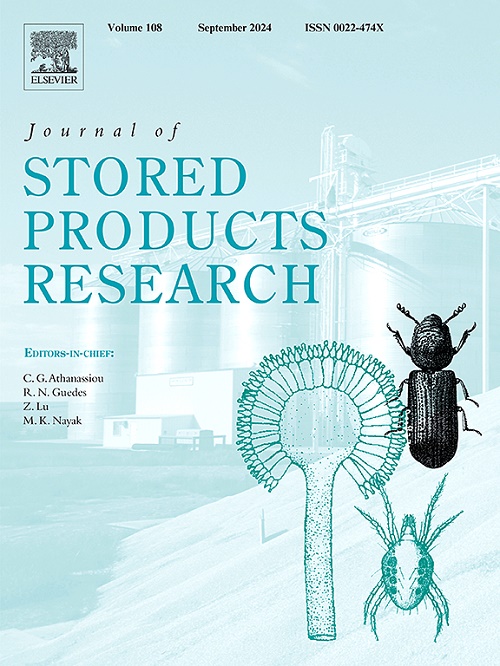氟酮作为谷物保护剂的潜力:用于控制储藏小麦中的小卷叶螟(Rhyzopertha dominica (F.))的长期药效和残留量
IF 2.7
2区 农林科学
Q1 ENTOMOLOGY
引用次数: 0
摘要
一项研究旨在评估合成生物杀虫剂氟虫脲作为一种潜在的谷物保护剂对小麦中的小粒螟(Rhyzopertha dominica (F.))的作用。寻找新的谷物保护剂至关重要,因为小粒螟对有机磷(OP)、氨基甲酸酯、合成除虫菊酯和幼虫激素类似物等各种杀虫剂具有遗传抗性。在小麦通过钻孔机装入大型(1 吨)贮藏袋时,分别用 0、60、90 或 120 ppm 的氟虫氨进行处理。处理后的小麦在昆士兰东南部的遮蔽环境条件下贮藏 13 个月,同时在处理后 1 周采集样本,并在 30 °C 和 55% 相对湿度条件下在实验室中贮藏 13 个月,以进行比较。对实验室和环境条件下储存的小麦进行的生物测定表明,根据对 F1 代的高抑制水平,60 ppm 的施用量至少可以保护小麦 13 个月免受易感菌株的侵害。在环境条件下储存的未经处理的小麦会受到严重的多瘤蚜侵染,而在任何处理中均未检测到多瘤蚜,从而进一步证实了氟虫氨作为一种有效谷物保护剂的潜力。不过,生物测定显示,60 ppm 的施用量只能保护一种对 OPs 和除虫菊酯类具有抗性的菌株 3 个月,这表明该菌株可能对非靶标部位具有抗性。90ppm 和 120ppm 的较高施用量可提供 13 个月的保护。正如其他一些谷物保护剂研究报告的那样,最初的氟虫氨残留量低于目标施用量,这表明有可能改进配方和施用方法。在整个研究期间,氟乐松的残留量保持相对稳定。我们相信,通过这项研究获得的数据将为确定这种新分子的田间施用量以及在工业上注册使用以减轻抗性问题奠定基础。本文章由计算机程序翻译,如有差异,请以英文原文为准。
Potential of flavesone as a grain protectant: Long-term efficacy and residues for controlling the lesser grain borer, Rhyzopertha dominica (F.), in stored wheat
A study was undertaken to evaluate the synthetic biopesticide, flavesone, as a potential grain protectant for the lesser grain borer, Rhyzopertha dominica (F.), in wheat. The search for new grain protectants is critical because of the propensity of R. dominica to develop genetic resistance to various insecticides such as organophosphates (OPs), carbamates, synthetic pyrethroids and juvenile hormone analogues. Wheat was treated with 0, 60, 90 or 120 ppm of flavesone as it passed through an auger into large (1 tonne) storage bags. The treated wheat was stored for 13 months under sheltered ambient conditions in southeast Queensland, and samples were also collected 1 week after treatment and stored for 13 months in the laboratory at 30 °C and 55% RH for comparative purposes. Bioassays of wheat stored under laboratory and ambient conditions, showed that an application rate of 60 ppm provided protection for at least 13 months from a susceptible strain, based on high levels of suppression of the F1 generation. Untreated wheat stored under ambient conditions became heavily infested with R. dominica, while none were detected in any of the treatments, thus further confirming the potential of flavesone as an effective grain protectant. However, bioassays showed that the 60-ppm rate only provided 3 months protection from a strain that was resistant to OPs and pyrethroids, indicating potential non-target site resistance present in this strain. Higher application rates of 90 and 120 ppm were required for 13 months protection. As reported in some other grain protectant studies, initial flavesone residues were lower than the targeted rates, suggesting potential for improving formulation and application methods. Flavesone residues remained relatively stable throughout the study period. We believe that the data generated through this study will provide foundation in establishing field application rate for this new molecule and its possible registration for use by industry to mitigate resistance problems.
求助全文
通过发布文献求助,成功后即可免费获取论文全文。
去求助
来源期刊
CiteScore
5.70
自引率
18.50%
发文量
112
审稿时长
45 days
期刊介绍:
The Journal of Stored Products Research provides an international medium for the publication of both reviews and original results from laboratory and field studies on the preservation and safety of stored products, notably food stocks, covering storage-related problems from the producer through the supply chain to the consumer. Stored products are characterised by having relatively low moisture content and include raw and semi-processed foods, animal feedstuffs, and a range of other durable items, including materials such as clothing or museum artefacts.

 求助内容:
求助内容: 应助结果提醒方式:
应助结果提醒方式:


